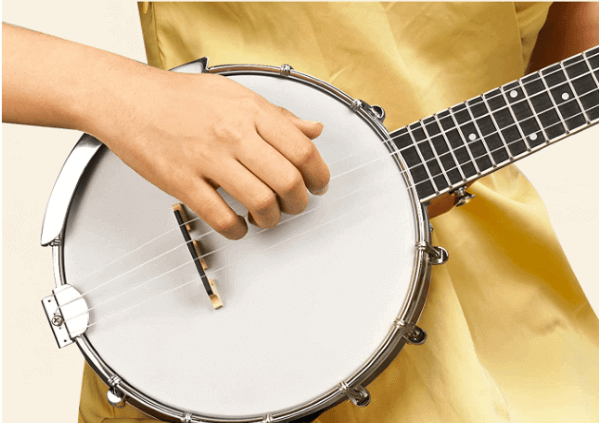It need not be that challenging to conveniently maintain a Savannah banjo, and that too in an excellent performing shape. Caring for your banjo is simpler than you would imagine maintaining a banjo in perfect shape. Your banjo would look terrific and sound fantastic for many years if you implement these easy instructions.
Your banjo won’t be harmed by dirt, grime, acidic oils, or unplanned accidents with just a little everyday maintenance.
It may not seem like much, but by developing merely three good habits, users can extend the life of any banjo and also help conserve all of its original features. My favorite aspect is anyone could do it, and that it costs a fraction of the major repairs that would otherwise be required.
Cleaning The Strings
- Dirty Strings Can Worsen & Degrade Banjo: Dirty strings won’t just look bad, but also sound bad. The banjo strings will degrade and worsen in quality mainly because of fretting or plucking them. Degradation happens as a result of friction as well as corrosion caused by the dirt deposited and acidic oils spread through your fingers.
- Wiping Off Dirt & Acidic Oils: Even though changing a banjo’s strings on a consistent basis will ensure its quality sound, you can prolong their lifespan with some simple measures. You can wipe off dirt and acidic oils from strings by running a clean cotton cloth up and down after each play session. As a result, the fretting hand can glide between notes much more easily while strings are protected from wear.
- Using String Cleaners & Cleansing Cloth: String cleaners are usually constructed of a mineral oil-infused cloth head housed in a tiny canister roughly comparable to a glue stick. Before clearing away any dirt and oil with an associated cleaning cloth, the head is cleaned up and down each of the strings. Just using cleaning products once before and after each session would then keep your strings gleaming for months.
Wiping Off The Body
- Examining The Remaining Portion Of Banjo: When strings are clean, examine the remaining portion of the Savannah banjo to ensure no additional nasties are accumulating around the body of the banjo. The very same acidic oils which corrode your banjo strings can also corrode the brackets, tension hoop, tuning pegs, and armrest. Such metals would then tarnish over time if not properly cared for, necessitating more deep cleaning.
- Accumulation Of Dirt On Wooden & Metal Parts: Dirt can accumulate mostly on wooden portions of your musical instrument as well, particularly on the back of the neck in which your thumb and palm slide upward and downward. This friction can indeed end up causing the finish of the musical instrument to degrade and fade over time. Dust impacts both wooden and metal parts equally and it will speedily pile up in the banjo’s many nooks and corners.
- Hygienic Cloth & Specialised Cleaning Materials: As with the wires, a simple, hygienic cotton cloth wiped down this same banjo after every play session would then remove the more visible offenders. To properly prevent both metal and wood parts, however, specialized cleaning materials for every surface should be considered.
- Using Cleaning Products With Care: When working only with the neck, rim, wooden headstock, and fretboard, use caution. A few cleaning products might very well be more harmful than beneficial according to the type of wood as well as if it has been handled with a finish. A fine, non-abrasive wax fabric that adds barrier protection layering to that same finish of Savannah banjos would then work wonders. A non-abrasive and chemically infused cleaning cloth will indeed be ideal for removing tarnishing from chrome and nickel in metal parts.
Keeping It Safe
- Inescapable Accidents & An Unsecure Bajo: Accidents are certainly inescapable despite the best efforts you make. Young children, pets, spills, or simply being distracted can all cause problems for an unsecured banjo. Furthermore, no one enjoys trying to lock things away after a game. Doing so will make it even more difficult to pick up once more. However, choosing to leave it against a wall and perhaps even near a couch increases the likelihood of it becoming damaged.
- Installation Of Wall Mounts: To avoid this issue, some users install wall mounts. Those kinds of wall mounts hold your Savannah banjo off the ground but within reach, while also openly displaying it in front of everyone. However, such a lasting fix is not suitable for everyone, in addition to the possibility of spillages and knocks.
- Balancing Safety & Accessibility: You should make your own decision about how to balance safety and accessibility. And there is no reason why users really cannot leave their banjo inside an unfastened soft case or perhaps an unzipped hard case for everyday use and retain nearly the entire extra security they offer. Depending upon when users take their banjo outside of the house, and also how far or where users take it, the hard or soft case may well be preferable.
The Takeaway
This only tends to take a few additional seconds to clean its strings before this and with each use, wipe the body thoroughly after playing, but also store your banjo. While it may appear tedious at first, if users make it a habit of accomplishing these three main things daily, they will soon become second nature. Through the exchange, you’ll get a banjo that looks way better, sounds nicer, and intones nicer for very much longer periods than if it’s neglected.
For additional guidance on getting the best from your musical instrument, take a look at our detailed Savannah Banjo review which covers everything.

I own a music instruments shop. My go to instrument is a banjo. My business makes it easier for me to access the instruments from various brands and of various types. I will give my honest opinion here to help out others in choosing the right instrument for them.





